|
Michael McFadyen's Scuba Diving - The Leap
On 29 April 1770, Lieutenant James Cook, RN, in HM Bark Endeavour entered Botany Bay and stepped ashore at Kurnell. Cook and his crew, including the famous scientist Sir Joseph Banks and his assistant Daniel Solander, explored the area of the bay and originally named it Stingray Harbour because of the large number of rays they caught. Cook stayed eight days and then headed north.
If Banks and Solander had been able to examine the waters of the bay in greater detail and to a greater depth, they would have discovered one of the most fascinating and beautiful of all sea creatures, the sea dragon. In an article on Inscription Point, I have discussed where and how to dive and be guaranteed to see at least 10 sea dragons on the one dive.
 |  |
| The entry point is right at the bottom | A drone shot shows the entry point is the spot
just to the right of the middle. See the stairs upper right.
Click to enlarge |
In this article I will describe a dive that is covers some of the same area as this dive but is an even better prospect for sea dragons and a more exciting dive. While doing this dive I have seen up to 20 sea dragons on a single dive and it not uncommon to see 10 or more. This is considerably more than in the late 1980s when you would only see a maximum of about seven or eight sea dragons on a dive. Note that since dredging of the bay for the port expansion in 2009, the sea dragons all but disappeared for the next 5 years. I saw two in January 2013, the first I had seen here for at least a year. Since then they have returned in larger numbers.
Both headlands of Botany Bay are part of Botany Bay National Park. The southern side is known as the Captain Cooks Landing Place section of the national park and is accessed from Captain Cook Drive at Kurnell. A fee is charged to use the park's facilities. NOTE: the park is closed at night, so night dives are not possible.
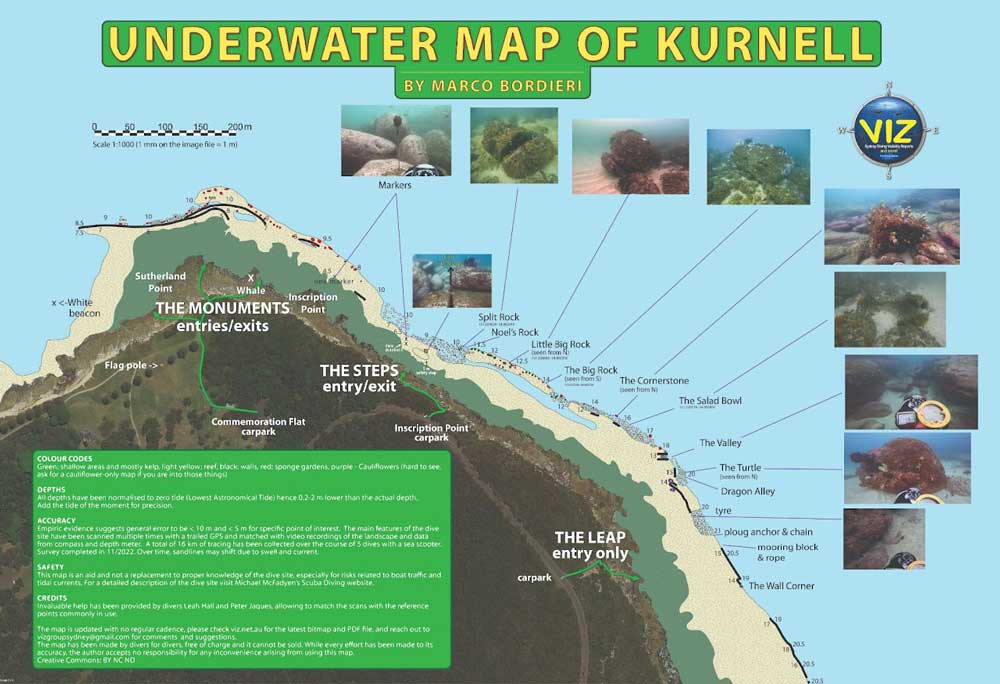 |
A new underwater map of Kurnell created by Marco Bordieri from www.viz.net.au.
For a much larger pdf version of this map, click here.
Used with permission of Marco Bordieri |
After entering the park, travel along the main park road towards Cape Solander and past the turn-offs to the visitor centre and Sutherland Point (named by Cook after one of his seamen, Forby Sutherland, who is buried nearby). About 1.5 kilometres into the park you will see a 90° parking area on your left running parallel to the roadway. This is Inscription Point/The Steps and is the finishing spot for the dive. If there is any sort of swell, stop here and check the exit site which is back to the west from the steps.
Anyway, before you gear up, first check that the entrance and exit spot is safe as it larger seas it can be very dangerous. If you walk down the first section you will see a narrow set of steps between rock. You can climb over the handrail on your left onto the flat rock and from here you can see near the entrance spot. Make sure there is nothing more than very low waves visible. Note that at very high tides even small waves can become difficult for exiting.
In addition, you can check before leaving home by looking at NSW Port Authority Wind and Tides website page. Look specifically at the Captain Cook (Directional) Wave buoy. Click on the link. If the swell is over 0.8 metres maximum, then it is probably not safe to dive here.
If the sea conditions are okay, continue past here to the top of the hill where you will see a very small parking area on the right side of the road. There is normally parking space available. Park here.
This is a different type of dive as the aim is to do it as a drift dive. You need to do the dive on an incoming tide. You can do it on any part of the incoming dive, but I would suggest entering the water at least 90 minutes before high tide at Fort Denison (in Sydney Harbour) as the tide sometimes turns a bit early and can make this a difficult dive.
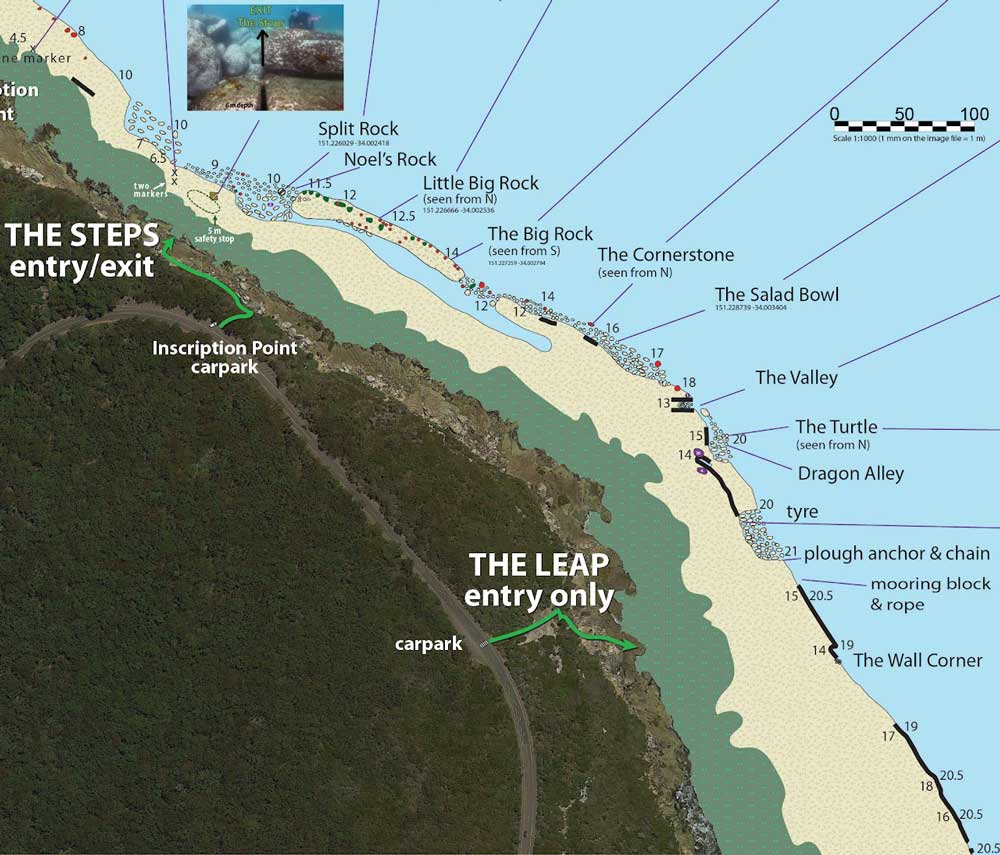 |
A larger version covering The Leap
Used with permission of Marco Bordieri |
After unloading all your gear at the top car park, set up your equipment and carry it across the road, together with your fins, mask and etc. Drive you car down to the car park halfway down the hill and park it near the steps. Put on your wetsuit and walk back up to the top of the hill and gear up.
Opposite the top car park there is a track that leads to the edge of the cliff. From here there is a roughly hewn set of stairs/track that leads down to the rock platform. In more recent years NPWS built a very good series of aluminium stairs to go over the harder sections. Back before this, in some places it was quite indistinct, and it could take you a little while to find your way. Quite a few years back I badly twisted my ankle near the bottom and was out of diving for three weeks (I still did the dive as it was easier to go back up at the end of the dive).
 |  |
| A close up of a sea dragon | A big belly sea horse |
From the top of the cliff you will see the entry point which is pretty obvious from the name of this dive, The Leap. The rock has a few spots where you can enter from, some higher than the others. Normally it is a high jump into the water but it is quite easy if you time it right.
As mentioned, there are actually a few different spots where you can enter the water, use the most suitable on the day. At a lower tide, you can get down onto the lower level and get in there. Remember, once you enter the water, you cannot get back on shore so you need to be certain that you have all your gear and that it is in good working condition. If you do have problems, you will need to snorkel nearly all the way back to the exit spot.
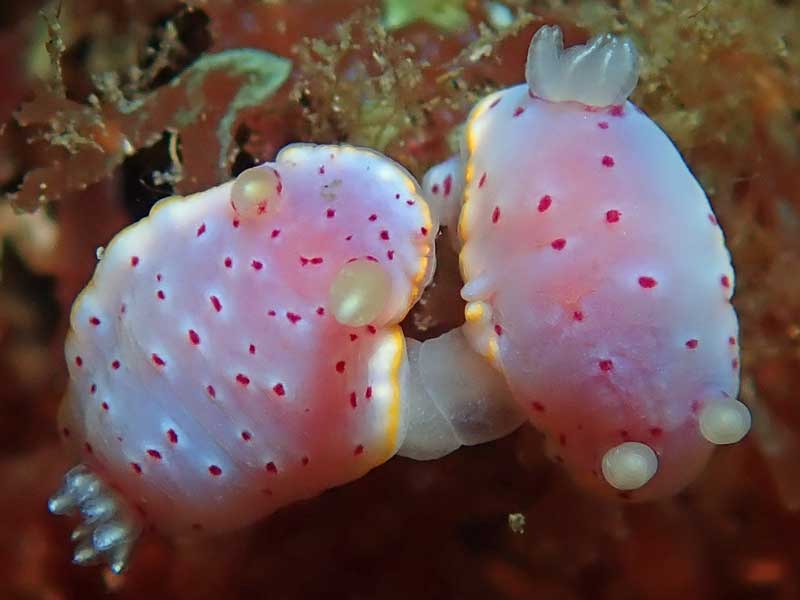 | 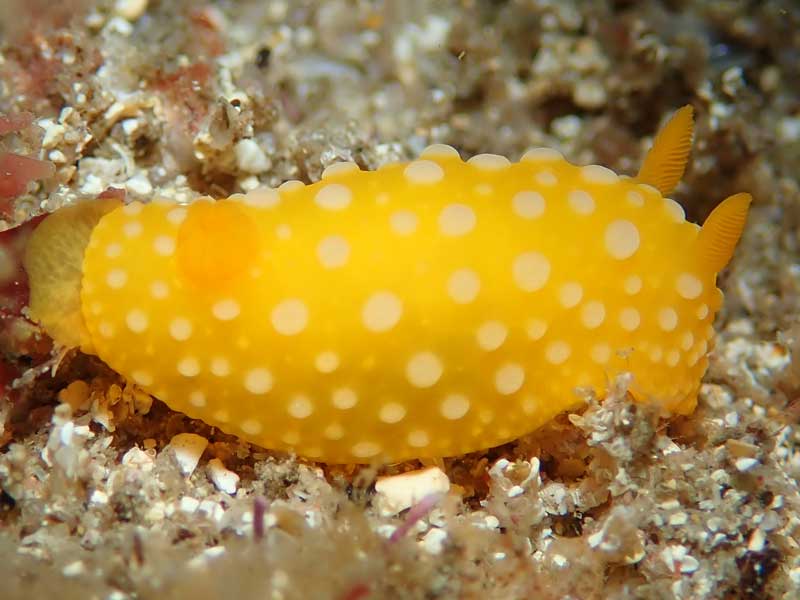 |
| Goniobranchus woodwardae | Lemon Lolly Doris Doris chrysodermane |
As soon as you enter the water, swim as quick as you can about 20 to 30 metres out away from the platform to get away from the swell that may smash you back into the rock platform. Descend here once all your group is gathered together. The depth here is 10 metres or so. The normal way to start this dive is by going to the north-east until you reach the sand edge of the reef. Once you reach this spot, turn to the left and follow the edge for as long as you want to. The depth is 21 to 22 metres and there are numerous small rocks, some connected to the reef and some like little islands.
If you are good on air and have dived this site a number of times, you can try an alternative start. For this, head east once you descend. You will go east or slightly to the north of east. After four minutes you will drop over a small wall and after six minutes over a large wall. You will now be on the sand, at about 21 to 22 metres. From here, head east or south-east (that is turn right ) into the current. In spots, this wall extends from 22 metres to 16 metres and there are many small overhangs. It is really quite spectacular.
 | 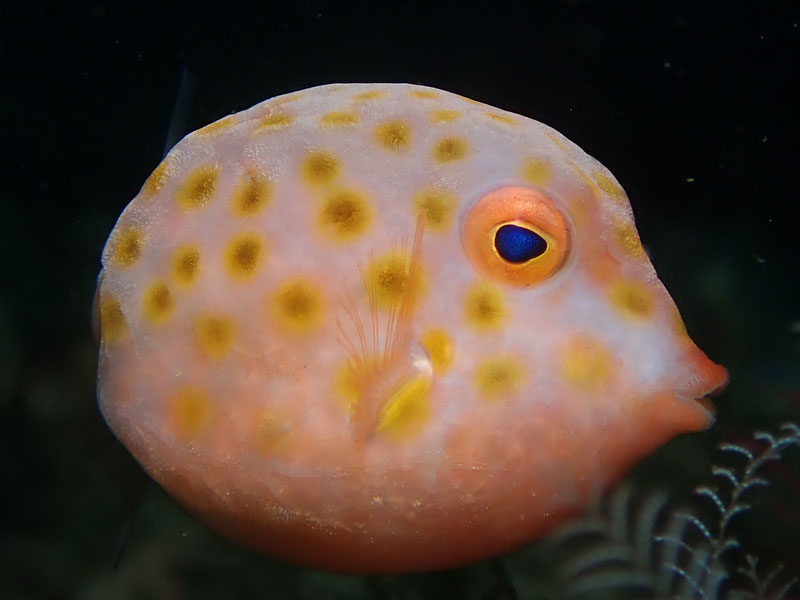 |
| Spindle cowrie | A small boxfish |
At about 15 minutes you will come to a small "bay" with two large boulders on the sand. Turn around here and head back towards the west. After about 25 minutes you will be back near where the normal dive meets the sand.
Normally once you hit the sand you should almost straight away encounter sea dragons. You must look carefully but once you get your eye in, you will normally see them everywhere.
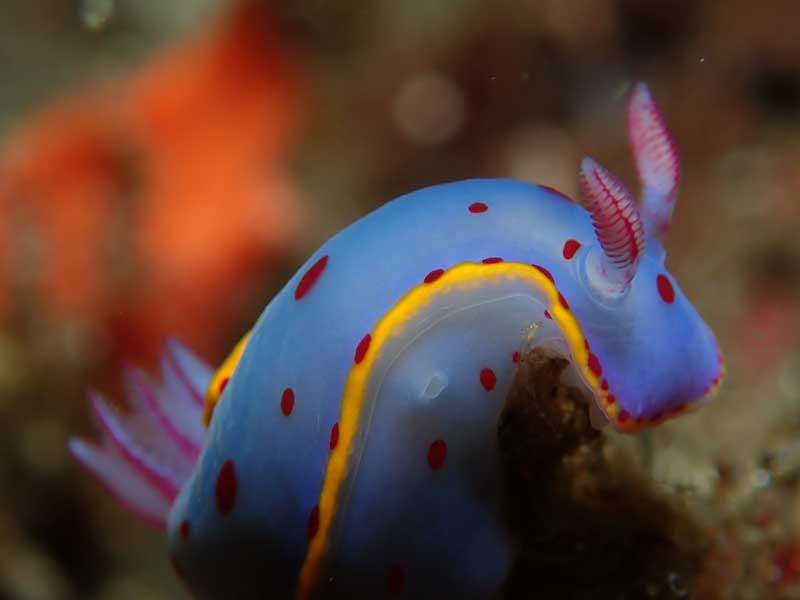 |  |
| Bennett's Hypselodoris Hypselodoris bennetti | Pancake Aphelodoris Aphelodoris varia |
Along the way the depth gradually gets shallower and the tide should let you travel without any need to fin. There are some excellent sponge gardens out here, but in closer they have been smothered by an imported weed but this somewhat abated in 1999 to 2000 but came back a bit about 2005. See the Inscription Point article for details.
There are numerous nudibranches on and amongst the sponges and the rocks are also home to numerous other species of animal, including giant jelly, magnificent and blue throated ascidians, lace coral, sea fans, tube worms and sea squirts. The sea dragons can be seen right up to about the 12 metre level. You should look carefully for they can easily be mistaken for pieces of kelp. They can often be found in the small "bays" of sand on the reef edge. These fragile looking fish move around ever so slowly.
 | 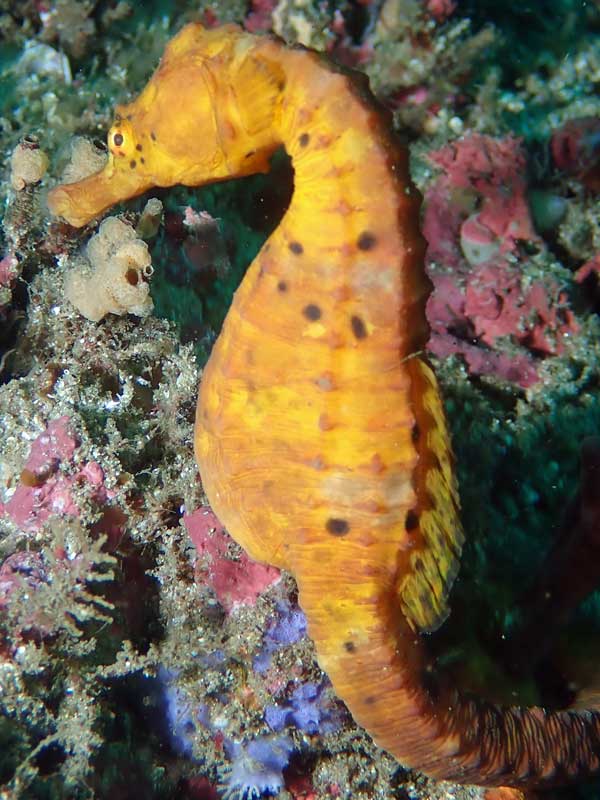 |
| A pink okenia nudibranch | A big belly sea horse |
In the late winter and early spring period look close and you might see a "pregnant" male.On 31 December 2000 I saw 20 sea dragons, including one "pregnant" male and three tiny babies. We also saw a sea horse, the first I have seen here. In May 2001 I counted 17 sea dragons on a dive that had fairly poor visibility. On 10 January 2004 I counted (and photographed) 19 sea dragons, of which about six were carrying eggs. One is a very distinctive animal, missing most of its tail. In January 2007 I saw 18 on this dive but in January 2009 only three.
After about 50 or so minutes you will be in the 10 metre depth range. Go up a bit shallower and then surface and check your position. If you are off the stairway near where you parked your car, submerge and dive for another five minutes.
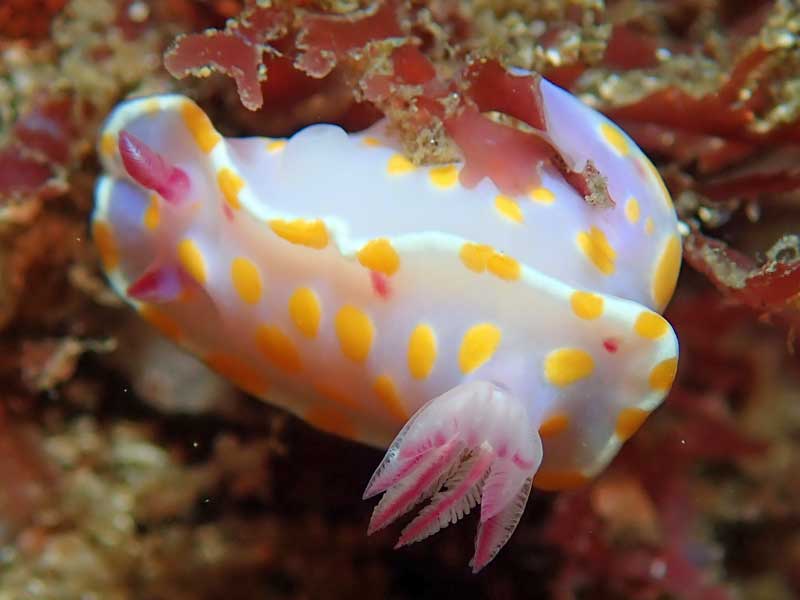 | 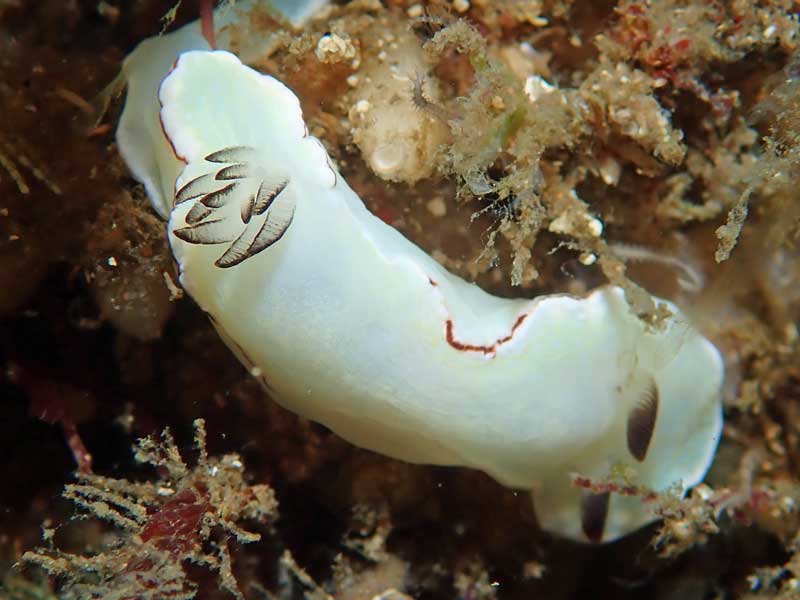 |
| Clown Doris Ceratosoma amoenum | Glossodoris angasi |
A very good exit point can be found in the small inlet to the west of the stairway, past the large overhanging rock. Surface, check your bearings and swim underwater into the inlet and pull yourself back onto the rock platform. It is an easy job to climb back onto the rock platform, but a much harder effort to return to your vehicle. You can, if you have plenty of air, continue on towards the bay and exit at The Monument (the grassy area). This section is also very good. When you get to nine metres and then deepen to 10 metres, head south-west and you will end up in the best area for exiting.
Apart from common sea dragons, other fish to be seen here are common stingrays, flatheads, leatherjackets of all sorts, bream, moray eels, small cuttlefish, old wife, bream, luderick, sergeant baker, blue groper and different types of wrasse and sometimes if you are lucky, a sea horse.
 |  |
| A small cuttlefish | Another boxfish, this one is a bit larger |
Visibility here is never great, with 9 metres being considered especially good. Six metres is probably a good average, but even when it drops to 3 metres you can still enjoy this dive as there are so many small things to see. On 31 December 2000 I had 15 to 20 metres, fantastic.
The Leap Drift is an excellent dive site, especially in southerly winds and seas when it is protected. Even in very large southerly/south-easterly swells you can normally dive here. Also good as a boat dive in southerly seas. Do as a drift by dropping divers at 34° 00' 22.5" S 151° 13' 41.3" E (using AUS66 as datum - if you do not, see my GPS Page for what this means) and following them towards the Bay. If the seas are from the north to east quarter and are big (over 1 to 1.5 metres) then forget about diving here, go to Sydney Harbour and dive Fairlight instead.
Note that this dive is only for experienced divers. A number of divers have come to grief on this dive, including one who on 7 January 2007 set off a search lasting 2.5 hours before a helicopter found him.
| 
 v6.00.307 © 2003-2005
v6.00.307 © 2003-2005